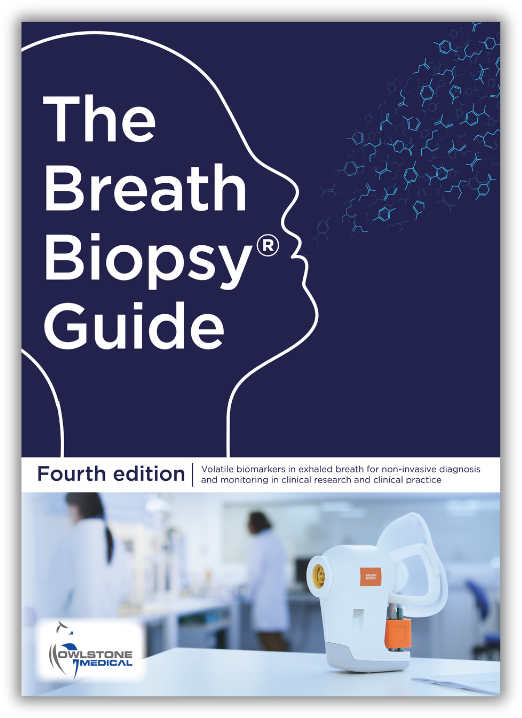We hope you enjoy the ‘Identifying Translational Biomarkers for Diagnostics and Drug Development Using Breath Biopsy In Vitro Headspace Analysis’ webinar
To turn on subtitles, click play, then click the “CC” button at the bottom right of the YouTube window.
Please make sure you accept cookies to ensure this webinar appears in your browser, please see our cookie policy for more options
00:00 – Introduction from Billy Boyle
00:47 – Introduction to Owlstone medical from Huw Davies
13:49 – In vitro Headspace for Liver Diseases from Giuseppe Ferrandino
31:12 – In vitro headspace Inflammation Response in bronchial from Agi Smolinska
49:28 – Q&A Session
Question & Answer session
For more details on using Breath Biopsy for in vitro sampling visit our in vitro sampling page, or get in touch to talk to one of our in-house experts.
In general, how long is the turnaround from when we ship samples to you, before we can expect to receive the results?
For human breath studies run through our Breath Biopsy OMNI platform this would be between 12 and 20 weeks depending on the level of statistics and reporting required. For the in vitro headspace analysis this would be between 8 and 10 weeks. These timelines include sample analysis by GC-MS, extraction of the raw MS data, preparation of a table of VOCs, statistical analysis and preparation of the report.
Could you elaborate on the normalization strategy you apply in your untargeted data analysis to account for inter-person and within subject variations?
We apply different types of normalization strategy, depending on the study. The strategies we use include a mixture of normalization with respect to internal-standards alongside a more sample based normalization strategy using probabilistic quotient normalization.
Please note: normalization is intended to remove the so-called ‘size effect’, associated with a different sample volume and/or sample concentration. Due to the ‘size effect’, the true signal (here compound) is unobservable, but what is observed is a signal that is multiplied by a constant, and the constants in general differ for different signals.
We avoid a total area normalization strategy, which is often used in metabolomics, because it is known to often produced spurious correlation between compounds.
What is the dynamic range of your system?
The systems we use are Orbitraps (Exploris 60 and Q Exactive). They have a large linear dynamic range, which is between 0.01 ng/uL to 100 ng/uL, on the column, making them ideal platforms for quantitative analysis.
The NAFLD/ NASH model is interesting. How you were able to measure IL6 and TIMP? What was the source of the cytokine?
IL6 and TIMP 1 were measured by using standard commercial kits. They were generated by co-culturing human hepatocytes with human Kupfer cells and human hepatocytes stellate cells.
Diabetes and Obesity are strongly associated with the etiology of NASH. Can you discuss how these metabolic states may affect your model?
Diabetes and Obesity are conditions expressed at the level of an organism. Therefore, it is impossible to recapitulate these conditions in vitro with only a few cell types. To induce the NASH phenotype, hepatocytes are treated with lipids, to mimic fatty liver often associated with obesity. Additionally, transcriptomic data from NASH hepatocytes suggested that hepatocytes become insulin resistant.
Bleomycin represents a very severe model to induce inflammatory lung processes. Is this approach (patho-)physiologically translatable to humans?
Bleomycin is an established model to look at inflammation and ROS production in the system studied. Indeed, the inflammatory process created by bleomycin can be severe, yet many compounds found via the in vitro model can be reproduced in human studies. The study we showed here, used low concentrations of bleomycin to mimic more closely the inflammatory processes occurring in human lungs.
In your time resolved experiment do you purge the cells with oxygen?
In the experiment we showed here, we did not purge the cells with oxygen. We used equilibrated cell media in an incubator equipped with 5% CO2. Since the cell-system we worked with was limited in size and we performed the analysis for just 24h, the approach we used was sufficient to keep the cells alive. However, in the future when the analysis has to be conducted over a period longer than 24h, we would definitely purge the cells with oxygen to keep them alive.
What type of Column and MS system do you use? Could you show the chromatography trace?
We use different types of columns, depending on study requirements. Commonly we use Stabilwax columns, which allow a very broad range of different volatile organic compounds to be detected and quantified. The MS systems we use are Orbitrap (Exploris 60 and Q Exactive).
Learn about breath biomarkers and their applications. Download our free ebook.
